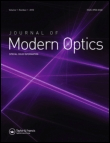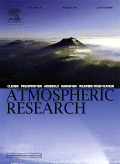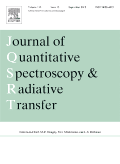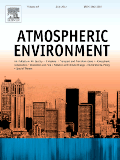
Atmospheric and Oceanic Optics
Scope & Guideline
Navigating the Complexities of Light in Earth’s Systems
Introduction
Aims and Scopes
- Optical Properties of Atmospheric Constituents:
Research articles often explore the optical characteristics of various atmospheric components, such as aerosols, clouds, and gases, to understand their role in climate and weather phenomena. - Remote Sensing Techniques:
The journal emphasizes the development and application of remote sensing methods, including lidar and satellite observations, to monitor atmospheric conditions and assess environmental changes. - Climate and Environmental Studies:
Studies focusing on the impacts of atmospheric changes on climate patterns, pollution, and ecosystem health are prevalent, highlighting the journal's commitment to addressing global environmental issues. - Numerical Modeling and Simulations:
Research frequently involves numerical simulations to model atmospheric processes, including radiative transfer, aerosol dynamics, and climate interactions, providing insights into theoretical frameworks. - Innovative Measurement Techniques:
The journal features advancements in measurement technologies, such as laser-based techniques and spectroscopic methods, to enhance the accuracy and efficiency of atmospheric observations.
Trending and Emerging
- Machine Learning and AI Applications:
Recent papers highlight the increasing use of machine learning and artificial intelligence techniques for data analysis in atmospheric research, indicating a trend towards integrating computational methods with traditional optical studies. - Climate Change and Its Effects:
There is a significant rise in research examining the impacts of climate change on atmospheric processes, including the behavior of aerosols and cloud formations, underscoring a broader concern for global environmental changes. - Advanced Lidar Technologies:
The journal has seen a surge in studies utilizing advanced lidar technologies for atmospheric monitoring, demonstrating an interest in enhancing observational capabilities and accuracy. - Interdisciplinary Approaches:
Emerging papers often combine atmospheric optics with fields such as ecology, hydrology, and meteorology, reflecting a trend towards comprehensive studies that address complex environmental issues. - Polar and Arctic Research:
Research focusing on polar regions and their unique atmospheric conditions has gained prominence, reflecting increased attention on the implications of climate change in these sensitive areas.
Declining or Waning
- Traditional Spectroscopic Studies:
There has been a noticeable reduction in papers focused solely on traditional spectroscopic methods without integration with modern technologies or interdisciplinary approaches. - Local Environmental Impact Studies:
Research specifically addressing localized environmental issues, such as urban air quality impacts, appears to be less prominent, possibly overshadowed by broader climate change discussions. - Basic Aerosol Characterization:
While aerosol studies remain vital, there has been a decline in basic characterization studies, with a shift towards more complex interactions and implications for climate modeling.
Similar Journals

JOURNAL OF MODERN OPTICS
Empowering Researchers in the Realm of LightJOURNAL OF MODERN OPTICS, published by Taylor & Francis Ltd, stands as a prominent bi-monthly journal contributing to the fields of Atomic and Molecular Physics and Optics. With an ISSN of 0950-0340 and an E-ISSN of 1362-3044, this journal aims to disseminate high-quality research that pushes the boundaries of optical science and its applications. Since its inception in 1981, and particularly throughout its publications from 1987 to 2024, the journal has consistently published influential studies that are essential for both academic researchers and industry professionals. Ranked in the Q3 quartile for the 2023 category of Atomic and Molecular Physics and Optics, it has a Scopus ranking of #133 out of 224, indicating its steady presence and relevance in the scientific community. Although it does not offer Open Access options, readers can access its rich repository of literature that delves into innovative optical methods, technological advancements, and theoretical frameworks. The JOURNAL OF MODERN OPTICS is an indispensable resource for those seeking to advance their knowledge and research in modern optical science.

Atmospheric Research
Advancing the Frontiers of Atmospheric ScienceAtmospheric Research is a premier journal published by Elsevier Science Inc, specializing in the field of Atmospheric Science. With a commendable impact factor, it holds a distinguished position in the Scopus rankings, being placed 14th out of 148 journals within its category and achieving a remarkable 90th percentile rank. This journal serves as a vital outlet for rigorous research on atmospheric processes, climate variability, and meteorological phenomena, providing a platform for scientists, researchers, and students to disseminate their findings and contribute to the advancement of knowledge in this critical field. Although it is not an open-access journal, its strong reputation and selective publication criteria ensure that only high-quality and impactful studies are featured. Since its inception in 1986, Atmospheric Research has continuously evolved to meet the dynamic nature of atmospheric studies, making it a fundamental resource for anyone engaged in understanding and addressing atmospheric challenges worldwide.

IZVESTIYA ATMOSPHERIC AND OCEANIC PHYSICS
Innovating research for a sustainable environmental future.Izvestiya Atmospheric and Oceanic Physics is a distinguished journal dedicated to advancing the fields of atmospheric science and oceanography, published by MAIK Nauka/Interperiodica/Springer. With a rich publication history spanning from 1972 to the present, this journal serves as a vital platform for both theoretical and experimental studies that enhance our understanding of complex atmospheric and oceanic systems. Despite its current categorization in the Q4 quartile according to the 2023 rankings, the journal continues to provide crucial insights, as evidenced by its established ranks in Scopus—placing it in the 15th and 26th percentiles of its respective categories. Researchers, professionals, and students alike are encouraged to contribute to and engage with the latest findings published in this journal, fostering a collaborative spirit within the scientific community dedicated to tackling pressing environmental challenges.

ATMOSFERA
Bridging Research and Environmental UnderstandingATMOSFERA is a prestigious journal published by CENTRO CIENCIAS ATMOSFERA UNAM, dedicated to advancing the field of Atmospheric Science. With an ISSN of 0187-6236 and an E-ISSN of 2395-8812, this bilingual journal has been a vital resource for researchers since its inception in 1988. Located in Mexico City, the journal serves as a platform for high-quality original research, reviews, and case studies that explore various atmospheric phenomena, climate issues, and environmental challenges. Although currently categorized in the Q4 quartile of Atmospheric Science, ATMOSFERA aims to contribute to the growing body of knowledge in the field and improve its ranking over the next few years, emphasizing rigorous scientific inquiry and fostering collaboration among scholars. Its accessibility and commitment to open communication make it an essential reference for professionals and students striving to understand and address complex atmospheric dynamics.

Environmental Science-Atmospheres
Shaping the future of environmental science and atmosphere studies.Environmental Science-Atmospheres is an emerging and dynamic open-access journal published by the Royal Society of Chemistry, dedicated to advancing research in the fields of environmental science and atmosphere-related studies. Launched in 2021, this journal serves as an essential platform for disseminating cutting-edge findings that address the complexities of atmospheric phenomena, pollution impacts, and overall environmental health. With a commendable Q2 ranking across various categories including Environmental Chemistry and Pollution, it solidifies its position as a vital resource for researchers, professionals, and students seeking to contribute to the understanding of environmental dynamics. The journal is indexed in Scopus, providing its contributors with significant visibility within the scientific community. Operating under a fully Open Access model since its inception, Environmental Science-Atmospheres ensures that research outputs are freely accessible, fostering collaboration and knowledge sharing essential for tackling global environmental challenges.

JOURNAL OF QUANTITATIVE SPECTROSCOPY & RADIATIVE TRANSFER
Exploring the depths of atomic and molecular insights.JOURNAL OF QUANTITATIVE SPECTROSCOPY & RADIATIVE TRANSFER is a prestigious academic journal published by PERGAMON-ELSEVIER SCIENCE LTD that serves as a leading forum for advancements in the fields of atomic and molecular physics, optics, and spectroscopy. With a commitment to publishing high-quality research since its inception in 1961, this journal has consistently contributed significant insights, furthering our understanding of the interactions between light and matter. Currently holding a Q2 ranking in Atomic and Molecular Physics and Optics, and Q1 in Radiation, this journal ensures a robust platform for researchers aiming to disseminate their findings and collaborate in this evolving field. With rigorous peer-review processes and a strong emphasis on quantitative methodologies, it is ideal for both emerging scholars and established professionals alike. Although it does not offer Open Access options, the journal remains an essential resource for anyone engaged in the rapidly advancing domains of quantitative spectroscopy and radiation studies.

OPTICA APPLICATA
Empowering Knowledge in Optical ApplicationsOPTICA APPLICATA, published by Wroclaw University of Science and Technology, is a crucial platform for advancing knowledge in the fields of Atomic and Molecular Physics and Optics. With an ISSN of 0078-5466 and an E-ISSN of 1899-7015, this journal serves as a vital resource for researchers, professionals, and students seeking to explore the latest developments and applications in optical science and engineering. Although currently categorized in the fourth quartile in both Atomic and Molecular Physics and Electronic, Optical and Magnetic Materials, its commitment to publishing high-quality research articles, reviews, and technical notes remains unwavering. The journal covers diverse topics from practical applications to theoretical insights and fosters a collaborative environment for global contributors. While it does not offer an open access option, the journal is accessible through university libraries and institutional subscriptions. With an eye towards bridging academic research with real-world applications, OPTICA APPLICATA is well-positioned to influence advancements in photonics and materials science through ongoing issues from 1988 to 2024.

TELLUS SERIES A-DYNAMIC METEOROLOGY AND OCEANOGRAPHY
Empowering Scholars with Open Access ResearchTELLUS SERIES A-DYNAMIC METEOROLOGY AND OCEANOGRAPHY, published by Stockholm University Press, is a prestigious open-access journal that has been at the forefront of research in the fields of atmospheric science and oceanography since its inception in 1983. With an enduring commitment to disseminating high-quality, peer-reviewed research, the journal has achieved a commendable impact factor, securing its position in the Q2 category for both Atmospheric Science and Oceanography as of 2023. The journal's significant reach is reflected in its Scopus rankings, being positioned at Rank #51 in Oceanography and Rank #77 in Atmospheric Science. With open access established since 2012, TELLUS SERIES A serves not only as a vital resource for researchers and professionals in these dynamic fields but also as an inclusive platform for budding scholars and students. Engaging with this journal allows readers to stay updated on the latest developments and groundbreaking discoveries that advance our understanding of climate systems and marine environments. Its editorial ethos emphasizes the cross-disciplinary integration of atmospheric and oceanographic studies, making it an essential publication for anyone invested in environmental research and policy.

Ukrainian Journal of Physical Optics
Connecting Scholars Through Cutting-Edge Optical ResearchThe Ukrainian Journal of Physical Optics is a premier publication dedicated to advancing the field of optical physics, particularly strong in atomic and molecular physics. Founded in 2000 and published by INST PHYSICAL OPTICS, this journal has established itself as a leading platform for innovative research and scholarly discourse in optics, ranking in the top quartile (Q1) within its category according to the 2023 metrics. With an impressive Scopus rank of #30 out of 224 journals in the field, the journal garners significant attention, claiming an 86th percentile ranking that underscores its academic prestige. Researchers, professionals, and students alike will find a wealth of cutting-edge studies and insights within its pages, supported by open access options, which ensures global dissemination of knowledge. As the journal continues to converge into 2024, it remains a vital resource for those seeking to explore the depths of physical optics and contribute to the evolving landscape of this dynamic field.

ATMOSPHERIC ENVIRONMENT
Connecting disciplines to enhance our understanding of the atmosphere.ATMOSPHERIC ENVIRONMENT is a premier journal dedicated to advancing the field of atmospheric science and environmental studies, published by Pergamon-Elsevier Science Ltd in the United Kingdom. With an impressive impact factor and recent rankings placing it in the Q2 quartile for Atmospheric Science and Q1 for miscellaneous Environmental Science, it stands as a leading source of high-quality research articles that bridge the gap between atmospheric phenomena and environmental issues. The journal, which has been disseminating significant findings since its inception in 1972, emphasizes an interdisciplinary approach, inviting contributions that address the pivotal challenges facing our atmosphere today. Although it does not currently offer open access options, the journal remains accessible through various academic platforms, ensuring that the latest research reaches its vast audience of researchers, professionals, and students who are striving to deepen their understanding of atmospheric processes. With a robust scope that encompasses a range of topics from climate change to air quality management, ATMOSPHERIC ENVIRONMENT is essential reading for anyone committed to fostering sustainable environmental practices and innovative scientific research.